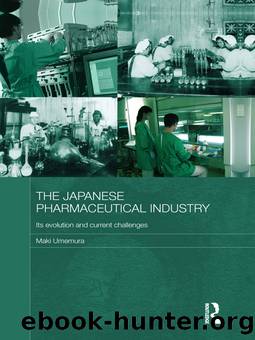The Japanese Pharmaceutical Industry by Umemura Maki;

Author:Umemura, Maki;
Language: eng
Format: epub
Publisher: Taylor & Francis Group
Published: 2011-08-15T00:00:00+00:00
5 Conclusion
Reconsidering Japanâs business in pharmaceuticals
This book has traced the history of the Japanese pharmaceutical industry since 1945. It explained how Japanese pharmaceutical firms recovered from the Second World War and then caught up with Western firms by importing technologies. The two case studies have also shown that Japanese pharmaceutical firms were able to develop a number of original, innovative therapies, some of which have proven successful in overseas markets.
The emphasis of this book, however, has not been on the achievements of the Japanese pharmaceutical industry, but rather on its relative weakness. Rather than invest heavily in R&D to pursue breakthrough discoveries, most Japanese firms opted to launch many new drugs with limited innovative value that could not be sold in other advanced markets. It was true that a handful of leading firms began to develop global blockbuster drugs and increase their overseas presence. But Japanese firms remained much smaller in terms of sales, workforce or R&D expenditures, and Japan remained a net importer of pharmaceuticals.
The aim of this book has been to explain why Japanâs pharmaceutical industry did not become a global leader, and continues to lag behind the pharmaceutical industries of countries such as the United States, the United Kingdom and Switzerland. I used two classes of medicines, antibiotics and anticancer drugs, as case studies for exploring the overall history of the Japanese pharmaceutical industry. I showed that the experiences of these two sectors were very different, and that the antibiotics sector was the stronger of the two. Japanese pharmaceutical firms were able to develop many antibiotics that came to be produced under licence in other industrialized countries. Japanâs anticancer drug sector was far less successful; it developed fewer globally competitive drugs and remained heavily reliant on imports.
There were several reasons why Japanâs antibiotics sector became stronger than the anticancer drug sector. Both sectors were heavily shaped by government policy. The MHWâs tendency to prioritize universal access to prescription drugs, however, had a disproportionate impact on the anticancer drug sector. The governmentâs cost containment measures, to set drug prices and reduce them regularly, limited the profits that pharmaceutical firms in Japan could gain from launching new therapies. Japanese firms were reluctant to invest in anticancer drugs, which were much more expensive and difficult to develop compared to antibiotics.
As the previous chapters showed, the search for new antibiotics was a more low-cost, labour-intensive and serendipitous process compared to the search for new anticancer drugs. In addition, whereas a given antibiotic could treat many infectious ailments, a given anticancer drug could only treat a particular type and stage of cancer. Antibiotics were more suited to mass production and allowed R&D expenses to be recovered over a larger number of consumers.
Pharmaceutical firms in Japan had much less incentive to develop anticancer drugs compared to antibiotics. Moreover, the undeveloped medical infrastructure and opaque drug approval process increased the risk and cost of drug development. Moreover, well into the 1980s, there was little demand in Japan for efficacious anticancer drugs, as these tended to have strong side effects.
Download
This site does not store any files on its server. We only index and link to content provided by other sites. Please contact the content providers to delete copyright contents if any and email us, we'll remove relevant links or contents immediately.
Application of a Novel Technique for Clinical Evaluation of Nitric Oxide-Induced Free Radical Reactions in ICU Patients by Unknown(693)
Rosenâs Emergency Medicine Concepts and Clinical Practice by Ron Walls; Robert Hockberger; Marianne Gausche-Hill; Timothy B. Erickson; Susan R. Wilcox(571)
Oxidative damage to surfactant protein D in pulmonary diseases by Vitality Starosta1 & Matthias Griese1†(406)
Social Science Perspectives on Global Public Health by Vincent La Placa & Julia Morgan(372)
Constructing Canine Consent; Conceptualising and Adopting a Consent-focused Relationship with Dogs by ERIN JONES(329)
Organic Chemistry: An Acid - Base Approach by MICHAEL SMITH(299)
ADVANCED EMERGENCY CARE AND TRANSPORTATION OF THE SICK AND INJURED by Unknown(271)
Saunders Nursing Drug Handbook 2024 - E-Book by Unknown(262)
Davis's Comprehensive Manual of Laboratory and Diagnostic Tests with Nursing Implications by Unknown(245)
Diagnostic and Statistical Manual of Mental Disorders, Fifth Edition, Text Revision (DSM-5-TR(tm)) by Unknown(245)
Socio-Life Science and the COVID-19 Outbreak : Public Health and Public Policy by Makoto Yano; Fumihiko Matsuda; Anavaj Sakuntabhai; Shigeru Hirota(244)
Human Microanatomy; Cell Tissue and Organ Histology with Celebrity Medical Histories by Stephen A. Stricker(242)
Berne and Levy Physiology E-Book by Unknown(234)
Replacing the Dead by Mie Nakachi;(229)
Handbook of Skin Disease Management by Jiyad Zainab;Flohr Carsten; & Carsten Flohr(228)
Access to Medicines and Vaccines in the South : Coherence of Rules and Policies Applied by the European Union Commission by Stephen Kingah(224)
The Pocket Guide to Sensorimotor Psychotherapy in Context (Norton Series on Interpersonal Neurobiology) by Pat Ogden(218)
Deep Learning and Medical Applications by Unknown(217)
Advances and Technical Standards in Neurosurgery by Unknown(213)
